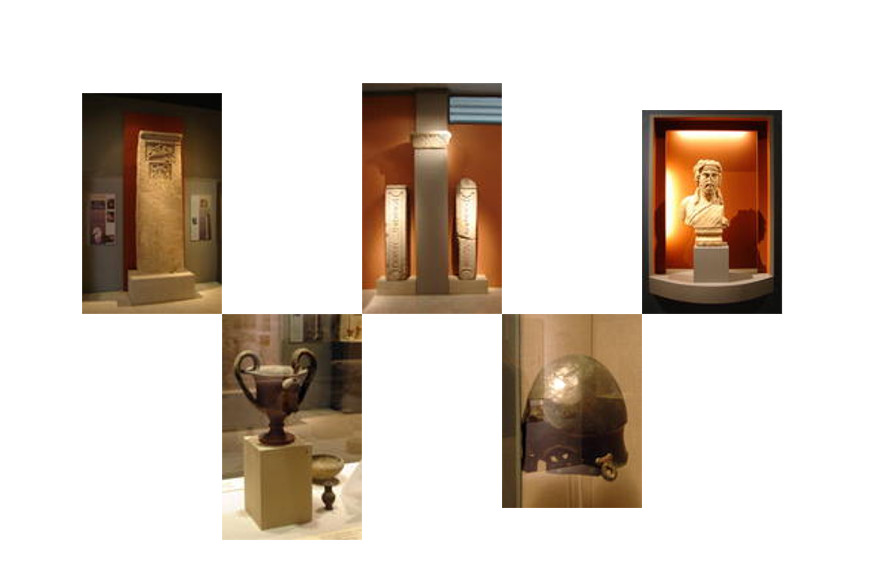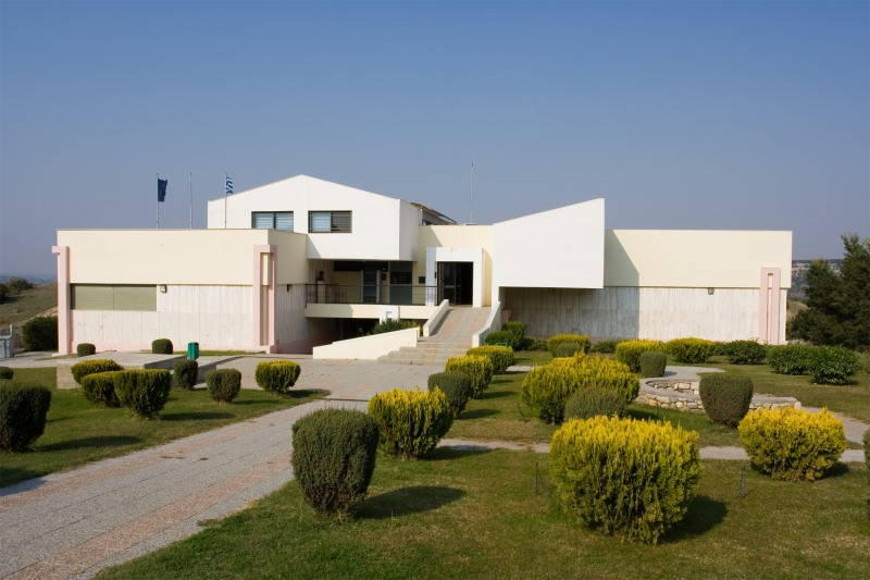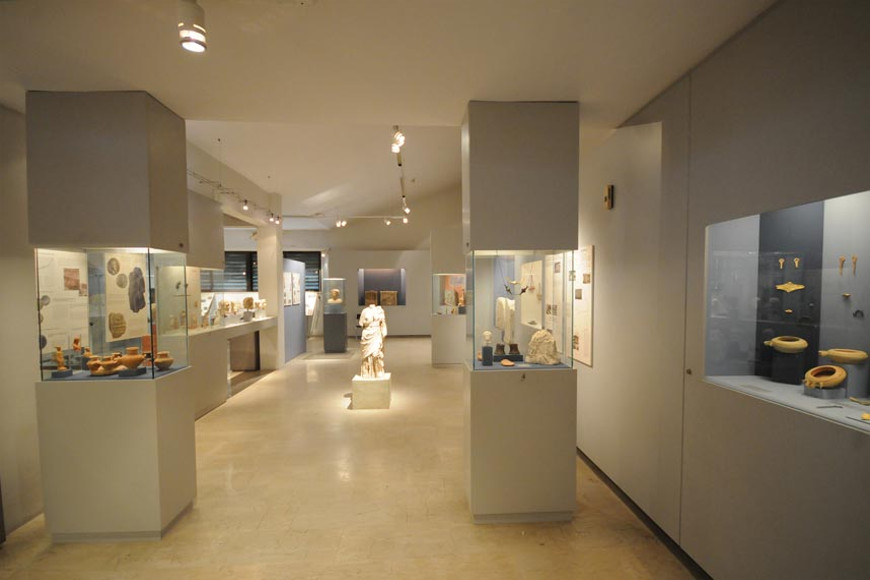This website uses cookies so that we can provide you with the best user experience possible. Cookie information is stored in your browser and performs functions such as recognising you when you return to our website and helping our team to understand which sections of the website you find most interesting and useful.
MUSEUMS

Archaeological Museum of Drama
The museum has been operating since 1999. The findings of the museum record the cultural history of Drama from the Middle Palaeolithic Age until 1914.
The earliest finds (bones and stone tools) come from excavations in the cave of the sources of the river Aggitis (50,000 BC), while tools, jewelery and vases are exposed from the prehistoric settlements of Sitges and Arcadian (6,000-4,000 BC) From the Early (many vases) and Late Bronze Age (findings from tombs in the rivers and the Exodus) and from the Early Iron Age (vases, weapons, tools and jewelery from tombs in the industrial area of Drama)
In the first room is a representation of a Neolithic, one-storied, clay house with its own housework (tools, stone, coral, earthenware, necessary for the daily Neolithic needs), a loom, figurines and ritual vases along with wooden benches, .
The museum also exhibits samples of Attic pottery (6th and 5th centuries BC), a marble bust of Dionysus, which is the oldest worship of the god in the wider region, a treasure of 860 coins by Philip II from excavations in the Potamos as well as other finds from the ancient settlement of Drama (4th century BC). Also important are the grave gifts, among which are those found in a Macedonian grave of Hellenistic times of the 2nd century AD. BC
Since the Roman era, most of the findings have come from the city of Philippi, such as the bronze statue of Zeus, but also from other areas such as the tombstone of Tiberius Claudius Maximus found in Grammeni. The findings come from the entire prefecture of Drama (Drama, Kalis Bryssi, Grammeni, Prossotsani, Platanias, Potamos).

Samples of the Early Christian period in the region are coins and pottery from the settlement of Drama and from Philippi. The monuments of the Byzantine era are scarce, most notably the stone sundial with engraved clocks (1069 AD) from the Paleohori area, vases, coins and jewelery from Drama, Adrianis and Xiropotamos.
Official Site of the Drama Archaeological Museum
Opening hours: Tuesday-Sunday: 08:30 – 20:00, Monday: 13:30 – 20:00
Distance from the hotel: 4.9 km

Archaeological Museum of the Philippi
The Archaeological Museum of Philippi was built in the 1960s, according to the designs of architects JD Triantafyllidis and D. Fatouros, on the outskirts of the Philippi archaeological site. The building has two exhibition areas for the permanent presentation of the finds from the excavations of the ancient city:
Module A: It occupies the entire ground floor and has an area of 380 sq.m. This section presents archaeological (inscriptions, sculptures, vases, coins, jewelery), historical and surveillance material of the city of Philippi and its region from prehistoric times to the end of Roman antiquity.
Module B: occupies the floor of the building with an area of 205 sq.m. and the Christian city (inscriptions, architectural members, mosaics, vases, coins) from the Early Christian years of acne to its shrinkage in the 7th century AD. century and its final desolation after the Turkish conquest at the end of the 14th century.
Opening hours: Tuesday to Sunday: 09:00 – 17:00
Museum Number: 2510616251
Distance from the hotel: 18.5 km
Archaeological Museum of Amphipolis
Amphipolis is located at a distance of two kilometers from the Thessaloniki-Kavala motorway at Serres, Drama, just above the estuary of the river Strymonas. There is the large archaeological site and museum. The Museum is housed in a new building completed in 1995.
All finds come from the surrounding area and reflect the timeless path of the city.
Entering the museum, one sees the silver reliquary and the golden wreath of olive leaves found in a tombstone at the founding of the museum.


The findings are presented in chronological order and include the following sections:
a) Prehistoric times (from Pangeo and Kettle Tepes hill) showing the continuous presence of man from the Middle Neolithic Era to the Early Iron Age (5000 BC – 750 BC)
b) Antiquity (from Kasta hill and from the cemetery of the Iron Age to Amphipolis). During this period the penetration of the Greek civilization in Thrace begins, as evidenced by the findings, mainly ceramic, in graves.
c) Classical and Hellenistic times. The city of Amphipolis itself was founded in 437 BC. by the Athenians.
The most important exhibits of this period come from the sanctuaries dedicated to local gods (Nymph, Muse Cleo, Roussos, Strymon) and the twelve (Athena, Aphrodite, Artemis) and heroes (Hercules, Dioskouroi) (from the ancient high school, the Hellenistic cemetery, the Hellenistic house, and excavations in the archaeological site).
Apart from the relics of the sanctuaries, there are many exhibits showing the public and private life in Amphipolis (coins, vases, sculptures, jewelery, miniature crafts). The citations of the necropolis show the richness and social position of the dead (vases, figurines, , jewelery).
d) Roman times. During this period the city’s acme continues, as shown by the mosaics from a Roman house and excavations in the cemetery of the region, as well as works of sculpture, pottery and miniature crafts.
e) Early Christian – Byzantine times. With the end of the ancient world (4th century AD) the area of the city decreases and with the establishment of the Slavs it is essentially dead. From this period, there are remains of five Early Christian basilicas with elaborate mosaics and a chapel found in a low position near New Amphipolis.
On the first floor there are finds from ancient Argilos and Iona, the harbor of ancient Amphipolis, as well as an explanatory dashboard for the history of ancient Amphipolis and its area.
Also, at the entrance of the Museum there is the correspondence of the historians of the 18th century. about the ancient Amphipolis, as well as photographs of the discovery of Leo of Amphipolis in 1913 and its restoration.
Opening hours: Tuesday – Sunday: 08:30 – 15:00
Museum Telephone: 2322032474
Distance from the hotel: 51 km


Museau Fortress of Lise
One of the Forts, the Fortress Lise, was built in the hill that rises in the plain of Nevrokopi and is located to the east of the fortress village.
Its fortifications consist of four groups of galleries (Turtles) all over the hill, with underground galleries exceeding 950 meters in total. Two of the clusters of galleries communicate with underground passages, while the other two are autonomous defense facilities.
The Fort had facilities, accommodation and storage facilities, water tanks, power generators, armaments and military vehicle seats. The Force Lise strength consisted of 12 officers and 457 hoplites.
Due to the necessary privacy and the need for camouflage, the fortress facilities are inconspicuous from the outside and access to several of its entrances is difficult. Visible is only a Chelon.
Official page of the museum.
Museum phone: 2523350144
Distance from the hotel: 50 km
Natural History Museum
The Museum of Natural History is located in Paranesti, Drama. Paranesti is a picturesque town 40 km from Drama, on the road from Drama to Xanthi via Stavroupoli. In October 2002, the Museum of Natural History started operating.
The museum aims to bring the world into contact with the natural environment of Rodopi and the Nestos valley and become the gateway to the ecosystem of the region with great biological and geological diversity.
Opening hours: Tuesday – Saturday 08: 00-14: 30, Sunday 11: 00-14: 30
Museum Tel: 2524350100
Distance from the hotel: 35 km


Mylopotamos aquarium
The Mylopotamou Aquarium is located 7 km west of the city of Drama in the Mylopotamos Municipal District towards the cave of Aggitis and the ski resort of Falakro. It is housed in an old stone refurbished watermill next to the Mylopotamos.
The Aquarium hosts only freshwater species and mainly from the Nestos and Strymon River
The fish of our country’s inland waters are one of the most important parts of Greek fauna and is considered by the experts to be the most threatened.
Of the 154 species of fish living in Greek rivers and in Greek lakes, 83 of them (66.4%) are endemic, ie they live only in the Greater Greece, are extremely rare, many of them are threatened and unknown in most of the world. Visiting the aquarium beyond the entertainment part is primarily educational.
Opening hours: Monday to Friday: 08: 30-13: 3, Saturday-Sunday: 09: 30-14: 00
Museum phone: 2521081579
Distance from the hotel: 14 km
bird predator park
The Park is located in the Drama Market in a beautiful natural environment. Respecting the visitors, the space and the housed birds, with proper configuration, maintenance and supervision, with provision and interest in accessibility and service, spaces have been created for viewing and visiting.
In the park the visitor has the opportunity to get to know many species of birds of prey and night birds and to go to the exhibition hall to watch various videos, photos and accessories for the birds.
Finally, experience culminates in the spectacular demonstration of free flight of trained birds of prey. You will be left unforgettable by the sight of the hawks that fly into the bait, fly up and go downhill at high speed or maneuver.
Official page of the museum.
Park Telephone: 2521026590 2521071794
Distance from the hotel: 12 km

SEE ALSO
PARKS & MONUMENTS
LEARN MOREWINERIES
LEARN MOREACTIVITIES
LEARN MOREMONASTERIES
LEARN MORENATURAL SIGHTS
LEARN MORE
Previous
Next



